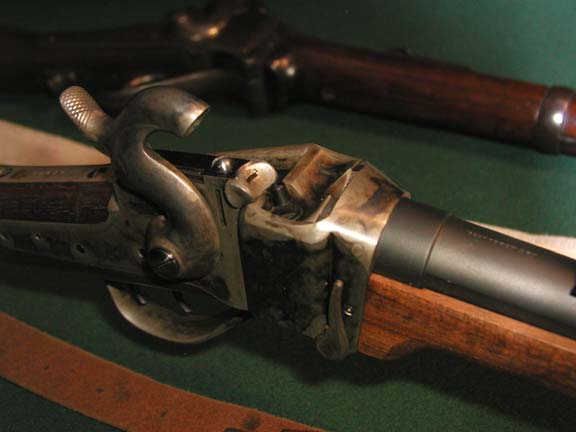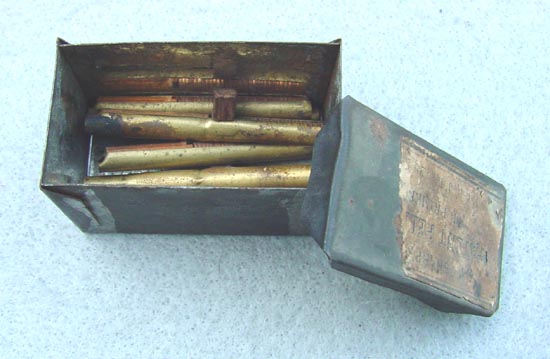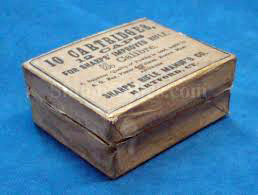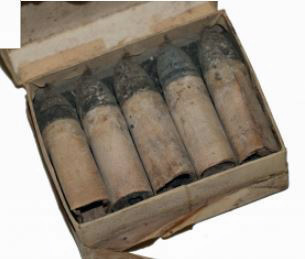

Berdan Special Order Sharps Rifle
This rifle was the standard Sharps New Model 1859 military rifle except for the following changes: 1) being fitted for the angular socket bayonet which used the front sight stud to lock it in place, no separate locking nut was on the bottom of the barrel which was present on the model which accepted the saber/sword bayonet. 2) the rifle was fitted with a doubleset trigger, by pulling the rear trigger, the forward "hair" trigger was set so that the slightest pressure would release the hammer. This special configuration did not have a lever locking latch which was on the trigger tang to hold the lever closed as on the single trigger Sharps rifle.


The standard features of the rifle were a straight type breech design, back action lock with exposed S shaped hammer and pellet primer system, a thirty inch round barrel, marked "Sharps Rifle/ Manufg. Co./ Hartford Conn." in three lines forward of the rear sight, and "New Model 1859" near the breech. Rear sights are found graduated to either 700 or 800 yards. Three spring held type oval barrel bands are used to hold the forestock in place. The metal parts of the rifle, which are the buttplate, sling swivels, and spring hinged patchbox are made of iron. The receiver and stock are not drilled or slotted to receive a sling bar, which was only used on Sharps carbines. Serial numbers are stamped on the upper stock tang and bottom of the barrel.
Army inspector's initials are found on the reverse buttstock at the upper wrist (stamped cartouche), and sometimes on the reverse side of the barrel at the breech.
JT Inspector Mark Pellet Primers


The original instructions to load the primers are below:
TO CHARGE THE LOCK WITH SHARPS PRIMER, Cock the Arm, shove back the magazine cover on the top of the surface of the lockplate, by pressing the left thumb against the screw head beneath the cup of the hammer . Withdraw the tack nail from the charging tube, insert the primers end of the tube in the magazine with the left hand, the slot in the tube in line with the slot in the face of the lockplate, and press it down as far as the spiral spring will admit, then with the right hand thrust the tack nail through the slots in the tube and lockplate above the primers, withdraw the tube, bring the lock to half cock and withdraw the tack nail. The priming magazine charged, the cover must not be moved back, lest the primers escape. Nor should the hammer be worked, between half cock and full cock, for the same reason.



Most Civil War rifles were caplock rifles requiring a percussion cap to fire. Percussion caps were developed in the early 1820's. It is a type of single-use percussion ignition device for muzzle loader firearm locks enabling them to fire reliably in any weather condition. Any firearm using a caplock mechanism is a percussion gun. Any long gun with a cap-lock mechanism and rifled barrel is a percussion rifle.
Overall length of the rifle is 47 1/8 inches and unloaded weight is 8 lbs 12 ounces.
Army Inspector's marks: John Taylor, assisted by four or five civilian sub-inspectors employed by the Army were borrowed from the Colt factory, they inspected all 2,000 of the special order Berdan Sharps rifles between April 10th and May 24th 1862. John Taylor's right hand slant cartouche with the scroll initials "J T" was stamped on all original buttstocks. His initial "T" hasing for him, the presence of other initials would not be unusual on the barrel if it's marked "New Model 1859". Rifles received by the Army in 1865 on the last contract have different inspector's initials, including "EAW" and "TWR" on the stock.
Sharps Serial Numbers: Identifying original Berdan Sharps rifle can be confusing. There appear to be two separate serial ranges for Berdan special order rifles.
1) serial range 54390 - 57574: This an estimated serial range, documented known Berdan rifles fall in this range of serial numbers. Both the 1st and 2nd regiments are known to have carried rifles in the 54000, 55000, 56000, and 57000 range.
2) serial range 39573 - 40872: This is a second range which is believed to have consisted of a few rifles that were "on hand" at the beginning of the Berdan contract and were used to begin filling Berdan's order. They may have been single triggers that were replaced with the double triggers. Some rifles exist in this range, but do not have the "J T" inspector mark or do they fit the profile of a Berdan special order rifle. No documented rifles exist and is estimated that less than 25 rifles in this serial range may have been produced.
List of Berdan Sharps Rifles known to exist, These rifles have the correct profile. doubleset triggers, fitted for angular bayonet and inspector's marks.
| 39573 | 54910 | 55817 | 56850b |
| 54390 | 54976 | 55942 | 56860 |
| 54412 | 54998 | 55968 | 56879 |
| 54478 | 55008 | 55990 | 56900 |
| 54492 | 55058 | 56113 | 56920 |
| 54538 | 55066 | 56219 | 57029 |
| 54549 | 55074 | 56309 | 57141 |
| 54549 | 55094 | 56314 | 57290 |
| 54571 | 55096 | 56452b | 57567 |
| 54580 | 55154 | 56507b,c | |
| 54610 | 55396 | 56736 | |
| 54665 | 55397a | 56739 | |
| 54716 | 55402 | 56799 |
Serial number information from the book: Sharpshooter: Hiram Berdan and his famous Sharpshooters and their Sharps Rifle: by Wiley Sword
Model 1859 Berdan Sharps Rifle with Malcolm scope mounted